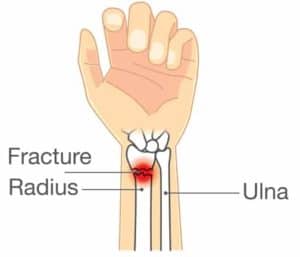Distal Radius Fracture
A distal radius fracture is the most common broken bone in the arm that affects wrist movement. Simply stated, a distal radius fracture is a broken wrist (or wrist fracture).
Forearm Bones
The radius and ulna are two bones of the forearm. The radius is the larger of the two bones. The end toward the wrist is called the distal end. When the radius breaks near the wrist, it is called a distal radius fracture.

Symptoms of a Distal Radius Fracture
A distal fracture is very painful. Other symptoms besides intense pain include:
- Tenderness
- Bruising
- Swelling
- Numbness or tingling feeling in the fingers
- Limited finger movement
- Deformed forearm or wrist
Type of Distal Radius Fracture
The angle at which the radius bone breaks determines the type of distal radius fracture. A distal radius fracture can be a Colles fracture or a Smith fracture.
A Colles fracture occurs when there is a direct impact to the palm due to an outstretched arm during a fall, an auto or bike accident, or from contact sports like football. It is characterized by a very noticeable bump on the wrist, which occurs because the broken end of the distal radius shifts up toward the back of the hand.
A Smith fracture occurs when there is an impact to the back of the wrist due to falling on a bent wrist. This type of fracture is less common and is characterized by a visible drop in the bone toward the palm side.
Causes of a Distal Radius Fracture
The most common cause for a distal radius fracture is falling onto an outstretched arm. The act of putting the arm out to catch yourself from injuring another part of your body or face can often lead to a wrist injury and severe fracture.
Other causes of a distal radius fracture include:
- Osteoporosis (bone are fragile and more likely to break)
- Trauma (e.g., car or bike accident, contact sports)
- A Fall from a standing position (common in people over 60)
Poor nutrition, loss of muscle mass, and chronic use of illicit substances can also cause weakened bones making them susceptible to this type of fracture.
Diagnosing a Distal Radius Fracture
Your doctor will order x-rays to diagnose the severity of the fracture and condition of the bone after the injury. X-rays will show if the bone is broken, if there is a gap between broken bones (displacement), and if the broken bone is in pieces.
Treatment Options for a Distal Radius Fracture
Treatment for a distal radius fracture includes both nonsurgical and surgical options. Your doctor will determine the best treatment option for you based on your answers to these questions:
- Have the bones shifted or become displaced due to the fracture?
- Did the fracture cause multiple breaks in the bone?
- Did the fracture also affect the joint bones?
- Did the fracture occur in the dominant hand?
- What is your occupation and activity level?
- Was there any other impact on the ulna or the median nerve?
Treatment options will naturally vary based on the type of fracture and its severity.
Nonsurgical Treatment
If the bone is displaced, it is reset into the correct position and then placed in a splint or cast for 6 weeks to hold the bone in place during healing. After 6 weeks, your doctor may further recommend a removable wrist splint to support the wrist during physical therapy. Physical therapy will help you to regain movement and strength in your wrist.
Surgical Treatment
In cases where the distal radius fracture is unstable and is not healing with a cast, your doctor may recommend surgery. Surgery is performed to put together the broken pieces of bone and hold them in place with plates and screws. However, if the bone breaks into multiple pieces, using plates and screws may not be possible. In such situations, an external fixator with or without additional wires may be used to secure the fracture.
A splint may be placed after surgery to protect the wrist from accidental movement and encourage quick healing. Once the splint has been completely removed, your doctor will recommend physical therapy to help you regain movement and strength in the wrist.
